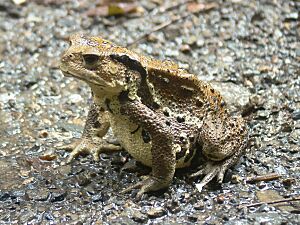Japanese stream toad facts for kids
Quick facts for kids Japanese stream toad |
|
|---|---|
 |
|
| Conservation status | |
| Scientific classification |
The Japanese stream toad (Bufo torrenticola) is a special type of toad found only in Japan. It's also called the Honshū toad. This toad was first described in 1976 by a scientist named Masafumi Matsui. He noticed it was a medium to large toad with unique colors and that it lived in streams.
These toads live in forests and rivers, mostly in the mountains of Japan. Sadly, their homes are shrinking, which means they are facing habitat loss.
Contents
Reproduction
How Japanese Stream Toads Have Babies
Scientists have studied Japanese stream toads in the rivers near Toyama Bay in Japan. They found that these toads sometimes breed with another type of toad called Bufo japonicus formosus. Both of these toad species are found only in Japan.
When these two types of toads breed together, their babies are called hybrids. These hybrid toads often look more like the Japanese stream toad. Because they look so similar, scientists often use special DNA tests to tell them apart. This helps them know which toads are pure Japanese stream toads and which are hybrids.
Spawning in Streams
The Japanese stream toad is thought to be the only toad in Japan that lays its eggs in streams. Most other toads lay their eggs in still water, like ponds or puddles.
In streams, these toads prefer to lay their eggs in quiet pools of water. They don't usually choose fast-moving parts of the stream or small puddles. One study watched these toads for two years. It showed that they used the exact same pools for laying eggs each year. This suggests that the toads might remember these spots. They might use clues like smells or physical features of the pool to find them again. It also means these pools might be very important for the baby toads to grow.
Why Toads Hybridize
Scientists have a theory about why Japanese stream toads and Bufo japonicus formosus toads sometimes breed together. Even though they usually lay eggs in different places, big floods might cause their breeding spots to overlap. If floods mix still puddles with stream pools, the toads might end up in the same places.
When they lay their eggs at the same time and in the same spots, it's easier for them to breed with each other. Both of these toad species are currently listed as "least concern" by conservation groups. This means they are not in immediate danger of disappearing.
Physical Features
How Stream Toads Are Built for Water
Because the Japanese stream toad is the only toad in Japan that lays its eggs in streams, it has special body features. These features help it live and move well in fast-moving water. They also help tell it apart from other closely related toads, like Bufo japonicus formosus.
Some of the main ways the Japanese stream toad is built for streams include:
- Long toes: Their toes are longer than other toads.
- Streamlined head: Their heads are shaped in a way that helps them cut through water.
- Large foot webs: They have bigger webs between their toes.
All these features help the Japanese stream toad swim and move better in strong currents.
When Masafumi Matsui first described this toad, he also noted some other things. He said it doesn't have bony ridges on its head (called cranial crests). He also observed that its limbs (arms and legs) are generally longer than a common toad, Bufo bufo. Lastly, he mentioned that its eardrum (tympanum) is smaller.


